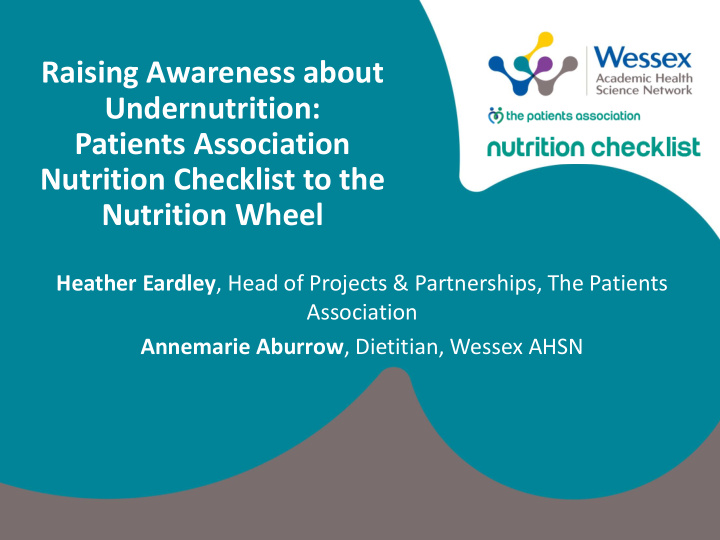



Raising Awareness about Undernutrition: Patients Association Nutrition Checklist to the Nutrition Wheel Heather Eardley , Head of Projects & Partnerships, The Patients Association Annemarie Aburrow , Dietitian, Wessex AHSN
Original checklist Adaptation of the developed & checklist by Wessex piloted by The AHSN for use in Patients Association domiciliary care Adaptation of the checklist for use Development of the with Fire Service & Nutrition Wheel Age UK Next steps
Who we are and what we do • Long established, independent charity • Non-disease specific • Helpline, campaigning and project work ‘listening to patients, speaking up for change’
Aims • To raise awareness of the possibility of being underweight or undernourished • To help identify the need for nutritional advice • To provide pointers for action To identify and help reduce under-nourishment
Focus of the nutrition checklist • In the community • Amongst those over 65 (especially frail elderly) • To be useful for people potentially at risk, relatives and staff • To be usable anywhere (not weights and measures) • To be simple and easy to fill in • To encourage conversations about nutrition and weight amongst families and with professionals
Evolution of the nutrition checklist • Created in 2016 – positive response • Partnership working to develop – Bournemouth University, Wessex AHSN, Malnutrition Taskforce • Pilot projects established with: – Domiciliary care – Fire Service and Age UK – GP practices in Buckinghamshire and Suffolk – Nutrition wheel • Aim to establish best model to take forward for future development
Elements of the nutrition checklist Section A: key questions to assess need for advice to gain weight or eat differently Section B: factors which may contribute to risk of under-nutrition (physical, social, appetite) Section C: next steps (including seeking advice from healthcare professional) plus tips, advice and information about eating
Patients Association Nutrition Checklist
Adaptation for use in domiciliary care • The original checklist was shortened and amended to include advice, signposting, leaflet suggestions and space to record action plan & next steps • Piloted with Pramacare, a domiciliary care agency in Poole • We provided training on undernutrition and the use of the checklist to 11 staff. A focus group was held at the end • Checklist was used on 15 of their clients • 40% (n=6) identified as at increased risk of undernutrition • Staff found the checklist easy to use with useful signposting • Pramacare plan to include the checklist in their ‘toolbox’, using it with those clients who are thought to be losing weight or are underweight
Adaptation for use with Fire Service & Age UK • Shorter version was required: Section A was condensed into 4 questions (removing a question around special diets) • Section B was condensed further and actions / signposting included specific to local & Age UK services • We approached Hampshire Fire & Rescue to discuss including Part 4 questions into their Safe & Well checks as part of a 3- month pilot • We approached Age UK Southampton to discuss receiving referrals from the First Service for any older people who were found to be at increased risk from these 4 questions • Early results suggest the checklist is easy to use and Age UK Southampton found it very useful in guiding the conversation
Development of the Nutrition Wheel 1. Results of a project we ran with Age Concern Hampshire in 2016 piloting the use of the PaperWeight Nutrition Armbands highlighted the need for an interactive tool to act as a conversation starter that includes the importance of asking questions to determine unintentional weight loss 2. In 2017, a group of 7 students from BU agreed to develop the questions and signposting / advice from the checklist into an initial prototype as part of their ‘Service Improvement Project’ 3. The students obtained some initial feedback from 7 volunteers in lunch clubs and 12 service users
Final prototype design by the students
Development of the Nutrition Wheel 4. The students obtained some initial feedback from 7 volunteers in lunch clubs and 12 service users – feedback included: Design easy to understand and straightforward to use – with or without volunteer Provision of national numbers helpful (especially Citizen’s Advice) A ‘friendly’ way to have the conversation Keen for the signposting advice on the information sheet 5. The Nutrition Wheel was further amended and 100 are being printed for piloting purposes. A tear-off information/advice sheet produced
Learning from projects using the nutrition checklist GP pilots still underway – end April: quantitative and qualitative evaluation Know already: can be very helpful for people and staff Know already: training about under-nutrition vital; needs a local champion and expert
Future plans for the nutrition checklist • Finish pilots and evaluate in April 2018 • Determine best model(s) for success • Seek partners to take forward to next stage • Consider wider roll out and potential take up • Establish research project to test
Next steps 1. Research study to To date we have attended look at concurrent 7 lunch / activity clubs in validity of the Part Hampshire, and collected A (four) questions data on 97 people with ‘MUST’ 2. 3. Collect data on the Further piloting of feasibility & the short version of usefulness of the the Nutrition Nutrition Wheel with checklist voluntary sector & care navigators
Recommend
More recommend